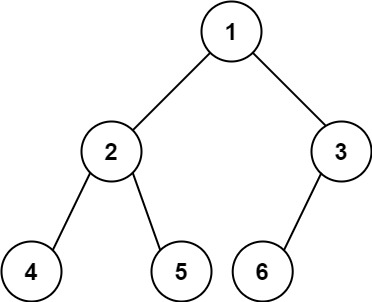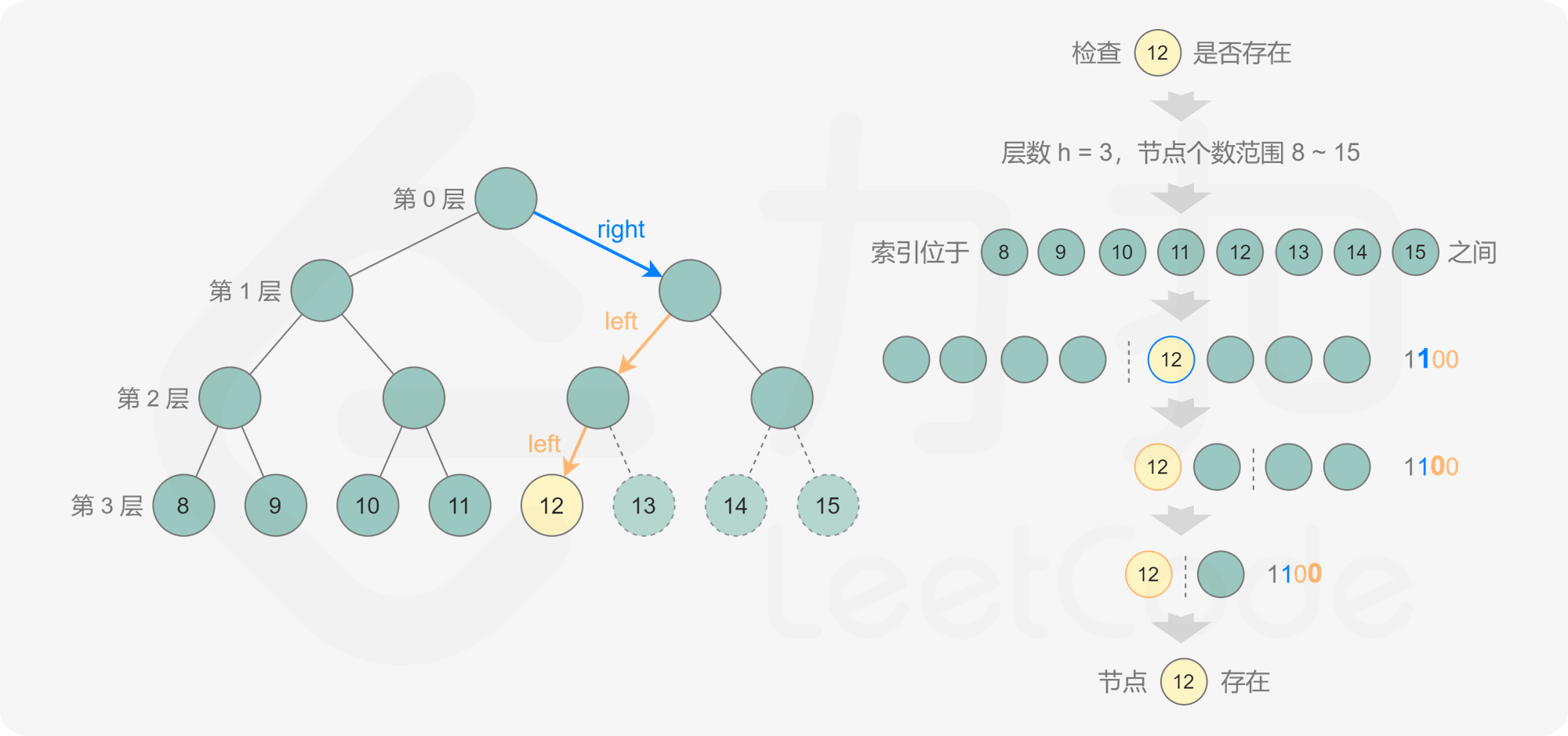问题
给你一棵完全二叉树的根节点 root ,求出该树的节点个数
完全二叉树的定义如下:在完全二叉树中,除了最底层节点可能没填满外,其余每层节点数都达到最大值,并且最下面一层的节点都集中在该层最左边的若干位置。若最底层为第 h 层,则该层包含 1~ 2^h 个节点
示例 1:
输入:root = [1,2,3,4,5,6]
输出:6
示例 2:
输入:root = []
输出:0
示例 3:
输入:root = [1]
输出:1
解法一:递归
递归遍历的顺序为后序遍历(左右中)
确定递归函数的参数和返回值:参数就是传入树的根节点,返回就返回以该节点为根节点二叉树的节点数量,所以返回值为
int类型。 代码如下:int getNodesNum(TreeNode cur)
确定终止条件:如果为空节点的话,就返回
0,表示节点数为0
if (cur == NULL) return 0;
确定单层递归的逻辑:先求它的左子树的节点数量,再求的右子树的节点数量,最后取总和再加一 (加1是因为算上当前中间节点)就是目前节点为根节点的节点数量
int leftNum = getNodesNum(cur.left); // 左int rightNum = getNodesNum(cur.right); // 右int treeNum = leftNum + rightNum + 1; // 中return treeNum;
class Solution {public int countNodes(TreeNode root) {if(root == null){return 0;}int leftNum = countNodes(root.left);int rightNum = countNodes(root.right);return leftNum + rightNum + 1;}}
解法二:迭代
//超时。。。。。。class Solution{public int countNodes(TreeNode root){if(root == null){return 0;}int res = 0;Deque<TreeNode> queue = new LinkedList<TreeNode>();queue.offer(root);while(!queue.isEmpty()){int size = queue.size();for(int i = 0; i < size; i++){TreeNode node = queue.poll();res++;if(node.left != null){queue.offer(root.left);}if(node.right != null){queue.offer(root.right);}}}return res;}}
解法三:二分法+位运算(官解)
左移运算符(<<):每左移一位,相当于该数乘2 右移运算符(>>):每右移一位,相当于该数除2
对于任意二叉树,都可以通过广度优先搜索或深度优先搜索计算节点个数,时间复杂度和空间复杂度都是 ,其中
n 是二叉树的节点个数。这道题规定了给出的是完全二叉树,因此可以利用完全二叉树的特性计算节点个数
规定根节点位于第 0 层,完全二叉树的最大层数为 h。根据完全二叉树的特性可知,完全二叉树的最左边的节点一定位于最底层,因此从根节点出发,每次访问左子节点,直到遇到叶子节点,该叶子节点即为完全二叉树的最左边的节点,经过的路径长度即为最大层数 h
- 当
0 ≤ i < h时,第i层包含2^i个节点,最底层包含的节点数最少为1,最多为2^h - 当最底层包含
1个节点时,完全二叉树的节点个数是 - 当最底层包含
2^h个节点时,完全二叉树的节点个数是
因此对于最大层数为 h 的完全二叉树,节点个数一定在的范围内,可以在该范围内通过二分查找的方式得到完全二叉树的节点个数
具体做法是,根据节点个数范围的上下界得到当前需要判断的节点个数 k,如果第 k 个节点存在,则节点个数一定大于或等于 k,如果第 k 个节点不存在,则节点个数一定小于 k,由此可以将查找的范围缩小一半,直到得到节点个数。
如何判断第 k 个节点是否存在呢?如果第 k 个节点位于第 h 层,则 k 的二进制表示包含 h+1 位,其中最高位是 1,其余各位从高到低表示从根节点到第 k 个节点的路径,0 表示移动到左子节点,1 表示移动到右子节点。通过位运算得到第 k 个节点对应的路径,判断该路径对应的节点是否存在,即可判断第 k 个节点是否存在
class Solution {public int countNodes(TreeNode root) {if (root == null) {return 0;}int level = 0;TreeNode node = root;while (node.left != null) {level++;node = node.left;}int low = 1 << level, high = (1 << (level + 1)) - 1; //1 << level:1向左移level位while (low < high) {int mid = (high - low + 1) / 2 + low;if (exists(root, level, mid)) {low = mid;} else {high = mid - 1;}}return low;}public boolean exists(TreeNode root, int level, int k) {int bits = 1 << (level - 1);TreeNode node = root;while (node != null && bits > 0) {if ((bits & k) == 0) {node = node.left;} else {node = node.right;}bits >>= 1;}return node != null;}}作者:LeetCode-Solution链接:https://leetcode-cn.com/problems/count-complete-tree-nodes/solution/wan-quan-er-cha-shu-de-jie-dian-ge-shu-by-leetco-2/来源:力扣(LeetCode)著作权归作者所有。商业转载请联系作者获得授权,非商业转载请注明出处。

